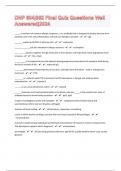_____ a mediator of common allergic responses, is an antibody that is designed to protect the host from
parasites and is the only inflammatory cell that can damage a parasite. - ✔ ✔ IgE
_______ makes up 90-95% of all bone cells - ✔ ✔ osteocytes
______________are also elevated in allergic reactions - ✔ ✔ eosinophils
__________anchors together the IgA molecules to form dimers and helps them resist degradation from
enzymes - ✔ ✔ the j chain
__________is transported across the placenta during pregnancy and protects the newborn child during
the first 6 months of life. - ✔ ✔ maternal IgG
________administered intermittently at low dose, stimulate bone formation - used in osteoporosis
treatment - ✔ ✔ PTH
________is a cofactor with PTH to promote Ca & Ph absorption in the gut and enhance bone
mineralization - ✔ ✔ vitamin D
______is non-mineralized bone matrix - ✔ ✔ osteoid
______molecules are found predominantly in the blood, whereas _____is the predominant class of
antibody found in normal body secretions. - ✔ ✔ IgA1, IgA2
2 types of cartilaginous joints and examples - ✔ ✔ symphyses (intervertebral discs) and
synchondroses (rib to sternum (hyaline cartilage))
3 phases of bone healing - ✔ ✔ inflammatory, reparative, remodeling
a joint in which hyaline cartilage connects the two bones (instead of fibrocartilage). - ✔ ✔
synchondrosis
A person is experiencing inadequate and delayed mineralization of osteoid in mature compact bone.
This description supports which diagnosis? - ✔ ✔ osteomalacia
acromegaly - ✔ ✔ GH secreting pituitary adenoma, age 40-59, usually death by heart issue, causes
giantism
,Activation - ✔ ✔ After platelets adhere they undergo an activation process that leads to the
conformational change in GPIIb/IIIa receptors, resulting in their ability to bind adhesive proteins
including fibrinogen and vWF
Changes in platelet shape
Formation of pseudopods
Activation of arachidonic pathways
Activin action in females - ✔ ✔ Stimulates secretion of FSH and pituitary response to GnRH and FSH
binding in dominant granulosa cells
Adhesion - ✔ ✔ Adhesion is initiated by loss of endothelial cells which exposes adhesive
glycoproteins such as collagen and vonWillebrand factor (vWF) in the subendothelium. vWF and other
adhesive glycoproteins in the plasma deposit on the damaged area. Platelets adhere to the
subendothelium through receptors that bind to the adhesive glycoproteins (GPlb, GPIa,IIa,GPIIb/IIIa)
Aggregation - ✔ ✔ Induced by release of TXA2
Adhesive glycoproteins bind simultaneously to GPIIb/IIa on two different platelets
Stabilization of the platelet plug (blood clot) occurs by activation of the coagulation factors, thrombin,
and fibrin
Heparin neutralizing factor enhances clot formation
Agonist - ✔ ✔ muscle that contracts to produce a movement, "prime mover"
Agranulocytes include - ✔ ✔ monocytes, macrophages, lymphocytes
ALL has too many ______ found in blood and bone marrow - ✔ ✔ lymphoblasts
AML has too many ______ found in blood and bone marrow - ✔ ✔ myeloblasts
amphiarthrosis - ✔ ✔ slightly movable joint
,anaphylactic shock is caused by - ✔ ✔ widespread hypersensitivity to an allergen that triggers
anaphylaxis
The production of mast cells, IgE,and low affinity IgE receptor is induced by a cellular response to the
antigen and contributes to the anaphylactic severity
anaphylactic shock management - ✔ ✔ Epinephrine is used for vasoconstriction and to reverse
airway constriction
LR for hypovolemia
antihistamines and steroids
Anemia of Chronic Disease - ✔ ✔ Mild to moderate anemia resulting from decreased erythopoiesis
and impaired iron utilization in individuals with conditions of chronic systemic disease or inflammation.
Common among hospitalized patients or those with CHF
Anemia of Critically Ill Children - ✔ ✔ caused by decreased erythropoietin activity, poor iron use by
the body, blood loss
Anemia of Infectious Disease - ✔ ✔ Congenital syphlis, toxoplasmosis, cytomegalic inclusion diease,
rubella, coxsackievirus B infection, herpesvirus infection, bacterial sepsis
antagonist - ✔ ✔ muscle that opposes or reverses or relaxes a prime mover
Aplastic Anemia - ✔ ✔ Hematopoietic failure or bone marrow aplasia characterized by reduction in
the effective production of mature cells by the bone marrow, causing pancytopenia
Pancytopenia (anemia, neuropenia, and thrombocytopenia) is a reduction in or absence of all three
blood cell types - erythrocytes, leukocytes, thrombocytes
Are bone tumors common in children - ✔ ✔ no less than 5% of childhood malignancies
As the strength, speed, and duration of stimuli increase, the summation of contractions reaches a critical
frequency called____ - ✔ ✔ tetanus- force cannot be increased once tetanus has been reached
attenuated vaccine - ✔ ✔ live, weakened viruses
, bartholin glands - ✔ ✔ secrete mucus that lubricates the inner labial surfaces, as well as enhances
the viability and motility of sperm
bone growth in length occurs at the - ✔ ✔ physial plate
bowed- leg appearance - ✔ ✔ genu varum
brace treatment (in scoliosis) is indicated for children with - ✔ ✔ curves of 25 to 40 degrees who
have at least 2 years of growth remaining.
bracing with scoliosis - ✔ ✔ only prevent progression of the curve, does not correct
BRCA1 and BRCA2 - ✔ ✔ Those with these gene mutations increase risk of breast and ovarian
cancer.
Cancers with familial tendencies - ✔ ✔ Breast, ovarian, colorectal, prostate
cardiogenic shock is caused by - ✔ ✔ heart failure or inability of the heart to pump adequate blood
to tissues and end organs.
caused by extensive myocardial damage and appears to be aggravated by a systemic inflammatory
response.
results in hypotension with metabolic acidosis
cardiogenic shock management - ✔ ✔ ultimate goal is reperfusion and revascularization
Cardiosupportive drug and fluid regimens (maintain adequate blood pressure and essential fluid and
electrolyte balance, and to optimize coronary perfusion to the myocardium)
mild hypothermia (increases contractility while decreasing oxygen demand and metabolism)
fibrinolytic therapies (medications that disintegrate the coronary thrombus)
percutaneous interventions (balloon angioplasty, stent placement, and thrombectomies)




